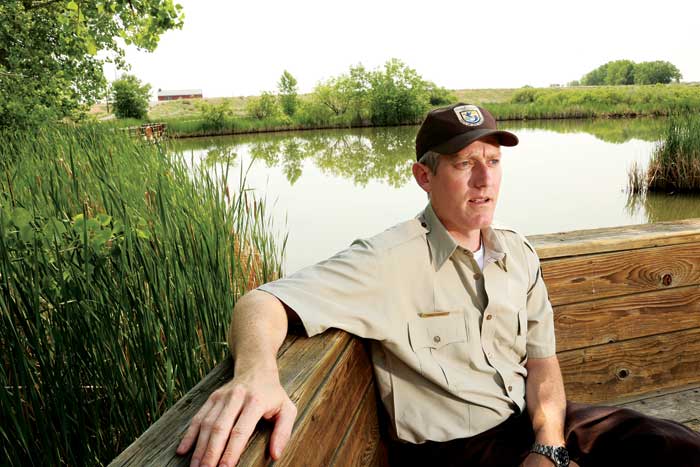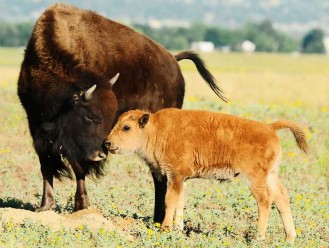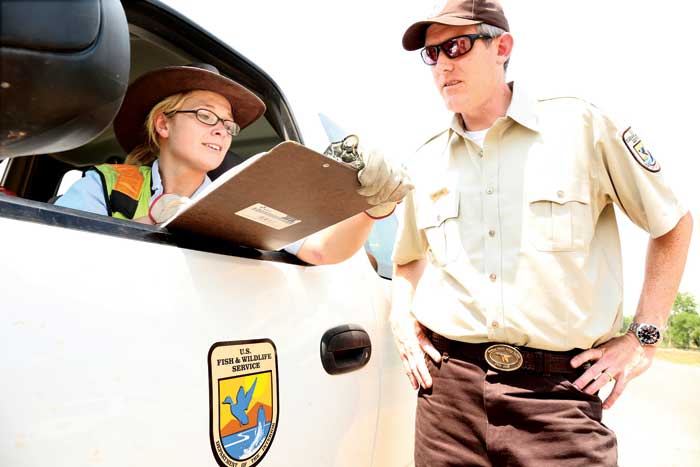
David Lucas, acting refuge manager, enjoys a peaceful spot at Lake Mary, one of the refuge’s several lakes.
“How do you think that deer got on the island?” Stapleton resident and Rocky Mountain Arsenal Acting Refuge Manager, David Lucas, asks a young boy visiting the arsenal with his grandfather on a bright, clear morning at the arsenal.
The curious young boy silently mulls over the question. He stares out from the dock at the deer lying on the island in the middle of Lake Mary, one of the arsenal’s several lakes.
After thinking silently for nearly 30 seconds, he shouts, “Deer paddled!” He swings both arms like a helicopter and runs in place.
Lucas, a tall, fair-skinned man dressed in a freshly ironed uniform, laughs and explains that unbeknownst to most people, deer can swim. The deer swam to the island to safely have her fawn.

Isabel Claire Roman, and her grandfather, John Lindemann, spot a deer as Lucas looks on.

The Rocky Mountain Arsenal is home to 78 bison. That number will double in the next ten years. Photo courtesy of Rich Keen – DPRA.
Times like this constantly remind Lucas why he loves his job. He is wild about conservation and education. While growing up in Kentucky, he was always interested in wildlife. He spent almost all his time outdoors and at age 10, he knew he wanted to work for the Department of the Interior.
After graduating with a degree in biology from Denison University in Ohio, Lucas went on to get his master’s and worked at the state Division of Natural Resources. He worked in the tallgrass prairie in Kansas, the mangroves in Florida, and in subtropical dry forests in Puerto Rico. Then six months ago he brought his passion for nature and conservation to the Rocky Mountain Arsenal National Wildlife Refuge (RMANWR). Lucas believes the arsenal is the premier urban wildlife center. Only a bike ride from Stapleton and a short drive from downtown, the arsenal is an easily accessible resource that allows people to connect with nature.
The 16,000-acre expanse equals four Stapletons, or the size of Manhattan. The refuge provides environmental education and interpretive programs, catch-and-release fishing, 10 miles of hiking trails, wildlife viewing and site tours. More than 330 species of animals including deer, coyotes, prairie dogs and burrowing owls live on the refuge. Seventy-eight cinnamon-colored genetically pure bison roam the site. During winter, nearly 80 bald eagles can be seen.
“From bugs to bison, every wildlife component plays an important role in balancing the ecosystem. Everybody out here has a niche,” Lucas says with a smile.

Amanda Allen, a student from St. Cloud State University in Minnesota and summer volunteer at the refuge talks with Lucas about her work.
The goal of the arsenal is to create a balanced prairie ecosystem. With its transition from farmland to wartime chemical manufacturing to refuge, the site is a conservation success story. But, to maintain a functioning ecosystem in an urban area takes a highly managed system. “Our goal is to get as close to what we call biological integrity, which allows systems to function the way they are supposed to naturally without human input,” he says.

Lucas stops for a bison to cross the road.
Reaching that biological integrity is an important function of a refuge. Lucas wants people to understand the difference between park and refuge. All aspects of a park are open to uses until the superintendent says they are not allowed. On a national wildlife refuge it is the opposite. “This entire property is here for wildlife first and (other) uses are opened,” he says. “We go through a process of opening uses and determining if that use is acceptable and compatible with wildlife.”
The refuge operates under a Comprehensive Conservation Plan that identifies specific goals for reaching the vision of the refuge. When the original plan passed in 1996, the needs and goals were very different from those of today. It was managed by the U.S. Army, and the focus was on cleanup from chemical manufacturing. With the completion of the cleanup plan in 2012 and the new visitor center in 2011, it’s time for a revised plan. A Master Revision Plan is in the works, which will consider adding more uses by people, like riding bikes.
Lucas is excited about the possibilities a new plan brings. Arsenal staff hopes to reintroduce the most threatened animal in North America, the black-footed ferret. They also plan to add more bison, renovate an old army building for environmental education, and more.
“We want to use this urban wildlife refuge to connect millions of people to conservation and the outdoors,” Lucas says. “There is no other place in America we can connect with people in such a great way.”
To check out what’s happening at the arsenal, visit: rockymountainarsenal.fws.gov. Also see upcoming events listed in the events list on page 19.


0 Comments